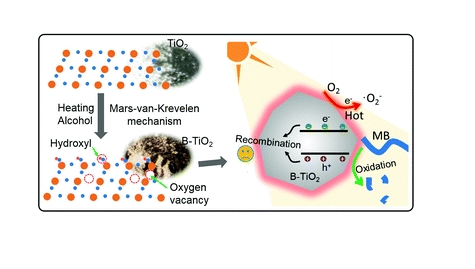Mars-van-Krevelen mechanism-based blackening of nano-sized white semiconducting oxides for synergetic solar photo-thermocatalytic degradation of dye pollutants
作者:Bao Haoming;Zhu Shuyi;Zhou Le;Fu Hao;Zhang Hongwen;Cai Weiping
期刊:NANOSCALE
卷(期)页:卷: 12 期: 6 页: 4030-4039
全文链接:https://pubs.rsc.org/en/content/articlelanding/2020/NR/C9NR09534A#!divAbstract

期刊:NANOSCALE
卷(期)页:卷: 12 期: 6 页: 4030-4039
全文链接:https://pubs.rsc.org/en/content/articlelanding/2020/NR/C9NR09534A#!divAbstract

Blackening (or enhancing the optical absorption in the visible region) of nano-sized white semiconducting oxides (N-WSOs) is of significant importance for solar utilization. Here, we present a novel Mars-van-Krevelen mechanism-based method for blackening the N-WSOs via facile one-step heating of the N-WSOs with alcohols. Taking n-butanol-induced blackening of TiO2 (anatase) as an example, the pristine TiO2 NP powders can be successfully blackened to form black TiO2 (B-TiO2) via heating with n-butanol at 300 degrees C for 20 min. Technical analyses demonstrate that the B-TiO2 nanocrystals are wrapped with a 2 nm thick disordered layer, which is rich in oxygen vacancies, Ti3+ and hydroxyl groups. Both theoretical and experimental results show that B-TiO2 has much stronger optical absorption in the visible region than pristine TiO2. Furthermore, the influence factors (including heating temperatures and alcohol types) and good universality of this blackening method are also demonstrated. A blackening principle based on Mars-van-Krevelen mechanism-induced oxygen vacancy generation and hydroxylation-anchoring of oxygen vacancies has been proposed, and the mechanism can well explain all the phenomena observed in experiments. Importantly, such B-TiO2 shows hugely enhanced activity in solar photodegradation of dye pollutants. Under simulated solar irradiation, the degradation rate constant achieved by the B-TiO2 catalyst is 2.3 times that of the pristine TiO2, showing an obvious enhancement. Further experiments reveal that the improved degradation activity is mainly attributed to the enhanced optical absorption in the visible region and the synergistic photothermal and photocatalytic effect. This study demonstrates a new and facile approach to blacken the N-WSOs for enhanced solar utilization.
